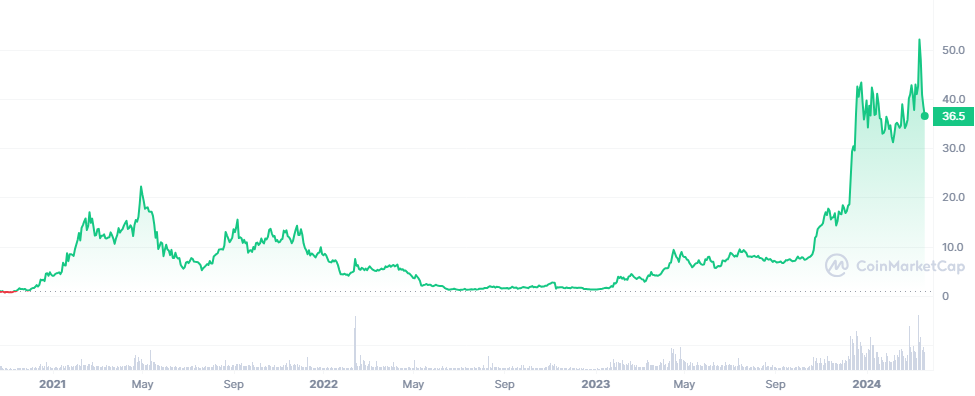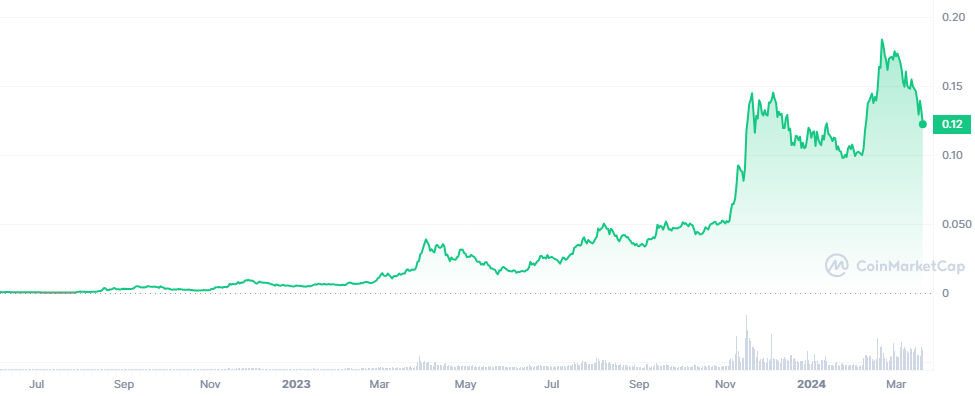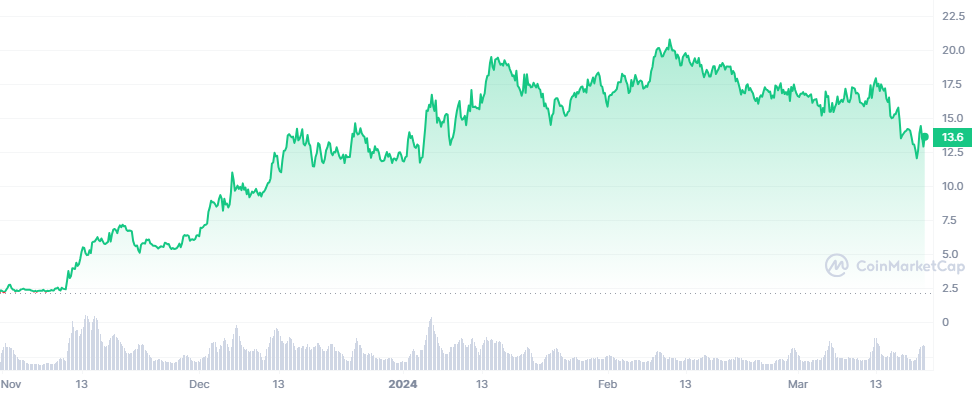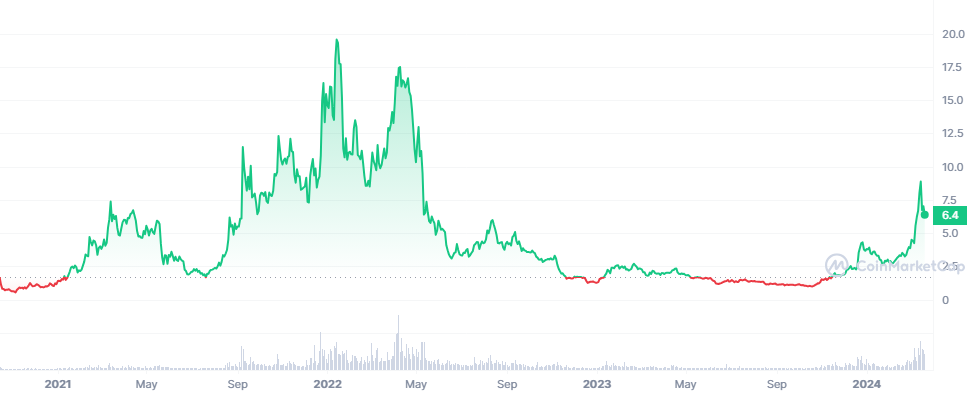Cryptocurrencies with the best future we have invested in
7 min readTable of Contents
In today’s article, we will look at cryptocurrencies with the best future that we have invested in. In our view, they have undeniable potential for longer-term growth.
Cryptocurrencies with the best future we have invested in – summary
- Injective – A Layer 1 blockchain powering next-generation DeFi applications.
- Optimism – A Layer 2 scaling solution for the Ethereum blockchain.
- Kaspa – A platform utilizing proof-of-work (PoW) and featuring a blockDAG architecture allowing for the parallel coexistence of multiple blocks.
- Celestia – A modular blockchain serving seamless data availability.
- NEAR Protocol – A Layer 1 blockchain that supports smart contracts and can process up to 100,000 transactions per second.
Cryptocurrencies with the best future we have invested in
Injective – A Layer 1 blockchain driving next-gen DeFi applications
With its remarkable gains over the last year, Injectice Protocol (INJ) has garnered significant attention within the crypto community. Investors and analysts are excited about the future development and potential of this token within the ever-evolving crypto ecosystem. The Injective project’s Layer 1 blockchain, built using the Cosmos SDK, enables secure, fast, and interoperable transactions across multiple blockchain networks. Injective offers a solution to the limitations of popular smart contract platforms, specifically designed and optimized for decentralized applications (DApps) in the DeFi sector.
What makes Injective Protocol exceptional is its focus on creating a fully decentralized exchange (DEX) that provides high scalability, security, and speed with the help of AI. The combination of AI and DeFi has proven to be a powerful catalyst for INJ’s price. The excitement around AI and the growing interest in DeFi have led to a significant price increase. Injective protocol’s unique positioning at the crossroads of these two trending areas makes it an attractive asset, especially for investors seeking innovative and future-oriented investment opportunities.
Analysts and industry observers highlight projects built on Injective Protocol. With increasing demand and continuous interest in AI and DeFi, INJ and similar projects could continue to emerge as prominent players. This means investors are offered particularly attractive return opportunities, albeit with corresponding risks. Given the exciting developments in AI, the growing popularity of altcoins, and the specific strengths of Injective Protocol, INJ could represent an exciting future for investors.
Optimism – A Layer 2 scaling solution for the Ethereum blockchain
Developed since 2019 and launched in December 2021, Optimism (OP) addresses one of Ethereum’s biggest issues: poor scalability, leading to long wait times and high transaction fees. In essence, Optimism conducts resource-intensive operations off-chain, delivering the final result to the Ethereum blockchain. This means transactions can be processed much more quickly and efficiently, increasing efficiency, reducing Ethereum network load, and significantly boosting the maximum number of transactions per second (tps).
With its native OP token, the platform has its governance token, allowing investors to invest and participate in the project. The creators of Optimism have further enhanced the rollup principle with batched transactions and rely on Optimistic Rollups. Transactions are considered valid unless proven otherwise. There is a seven-day period in which the validity of transactions can be disputed. Only after this period will the transaction be permanently recorded on Layer 1, with capital at the Layer 2 level being frozen for security reasons until then.
A major advantage of Optimism’s solution and the Optimistic Rollup method is compatibility with the underlying chain – in this case, the Ethereum blockchain. This Layer 2 solution works with all Ethereum dApps, from NFTs and marketplaces to extensive decentralized finance (DeFi) applications, allowing for decentralized implementation of financial services on the blockchain. As of May 31, 2022, the Optimism platform has its OP governance token, making token holders members of a decentralized autonomous organization (DAO) and allowing them to have a say in requests related to protocol changes, technical updates, or the direction of the project. The more tokens an individual or institution owns, the greater their voting power.
Kaspa – A platform utilizing proof-of-work (PoW) and incorporating blockDAG architecture enabling parallel coexistence of multiple blocks
Kaspa (KAS) is an innovative blockchain project that combines the security of the PoW mechanism with high block rates and minimal confirmation time. Thanks to its unique features and commitment to scalability, Kaspa has the potential to become a significant player in the field of decentralized applications. The consensus mechanism of Kaspa’s blockchain is combined with a blockDAG (Block Directed Acyclic Graph) structure to allow for the parallel coexistence of multiple blocks.
The project strives to maintain the core consensus elements of Bitcoin (BTC), including PoW mining, deflationary monetary policy, and decentralized governance, while drawing inspiration from Satoshi Nakamoto. Unlike conventional blockchains, Kaspa uses the GHOSTDAG protocol, which maintains high block speeds while ensuring secure operation. Kaspa aims to operate at higher speeds of 10 or even 100 blocks per second, although it currently processes only one block per second.
Another remarkable feature of Kaspa is its distinctive monetary policy. This design utilizes geometric emission reductions, implemented gradually and modeled on a 12-note musical scale. The maximum supply of Kaspa tokens is 28.7 billion coins, issued monthly and halved annually. With rapid block metrics and blockDAG architecture, Kaspa seeks to decentralize KAS mining and enable efficient mining even at lower hash rates. This project quickly gained popularity in the crypto community, with the KAS token experiencing a remarkable 61,000% increase since its market introduction.
Celestia – A modular blockchain that ensures seamless data availability
The crypto market welcomed a promising new player named Celestia in late October 2023. Celestia (TIA) token landed directly in the top 100 largest cryptocurrencies following its airdrop on October 31, 2023. Since this airdrop, TIA’s price has seen an impressive 675% increase at the time of writing. Celestia aims to be a modular blockchain primarily responsible for the data availability (DA) layer. Data availability in blockchain refers to the concept that all data related to transactions is accessible to all network users. In a modular blockchain, essential blockchain elements are executed by various blockchains and solutions. By providing multiple layers with specialized technology for each layer, blockchain scalability can be further enhanced.
Celestia has successfully raised $55 million in the past and is one of the leading projects focused on modular blockchain technology. Celestia’s growing ecosystem attracts projects from all areas of the crypto industry, including rollups, DeFi applications, and more. It enables the creation of a multi-chain modular ecosystem utilizing Celestia as the foundational layer for security and data availability. Teams can create independent chains tailored to their specific needs with their own transaction execution rules.
Celestia’s modular approach means separating the most critical layers of blockchain operation, offering much greater freedom in designing Web3 solutions. It is a Cosmos ecosystem project aiming to be the main data availability database. According to the project’s creators, “Modular blockchains will define the next decade of Web3.”
NEAR Protocol – A Layer 1 blockchain supporting smart contracts and capable of processing up to 100,000 transactions per second
Near Protocol (NEAR) is an easy-to-use and scalable blockchain protocol operating in a carbon-neutral manner. It functions as a community-driven cloud computing platform aimed at addressing other blockchains’ shortcomings, such as slow transaction speeds and poor interoperability. Near uses human-readable account names as an alternative to crypto addresses to make the platform user-friendly.
Moreover, NEAR employs its consensus mechanism, Doomslug, ensuring that blocks are added to the blockchain immediately after a transaction. Additionally, Near Protocol, with its Nightshade technology, has significantly increased transaction throughput to more than 100,000 per second. By solving other blockchains’ scaling issues, Near Protocol has been extremely popular among investors since its introduction. NEAR has become the foundation for many successful decentralized applications (dApps). NEAR is the native token of Near Protocol and also serves as the ecosystem’s governance token. It is used for various functions within the network, including paying transaction fees and staking to activate validator nodes. One billion NEAR tokens were issued in 2020, with additional tokens released annually to support the network.
Despite NEAR Protocol’s features, it’s important to note that Ethereum remains a better blockchain for smart contracts. Many developers continue to create their applications on Ethereum. NEAR Protocol acknowledges this and does not intend to compete with Ethereum, which might sound unusual. Instead, it aims to collaborate, developing a technology called Rainbow Bridge. This bridge creates a connection between Ethereum and the NEAR Protocol. In many aspects, Near Protocol already surpasses other blockchain networks. Its high scalability and excellent user-friendliness, integrated with governance features, make NEAR exceptional for the future.
Cryptocurrencies with the best future we have invested in – final words
As blockchain evolves, these platforms signify the continuous efforts to overcome the sector’s existing limitations, offering a beacon for the development of more secure, efficient, and scalable blockchain ecosystems. The integration of AI, innovative consensus mechanisms, and modular designs showcases a rapidly advancing field, poised to redefine our digital and financial landscapes. The future of blockchain looks promising, with these technologies at the helm, steering towards a more interconnected and decentralized world.











